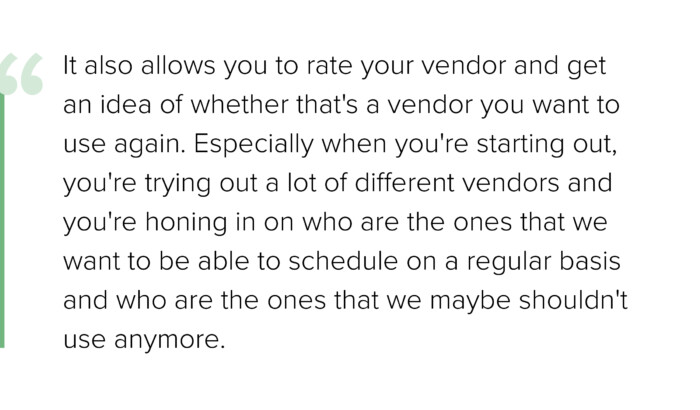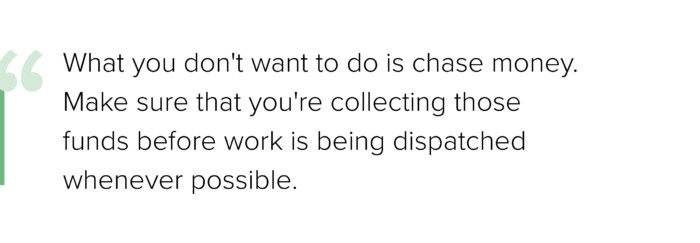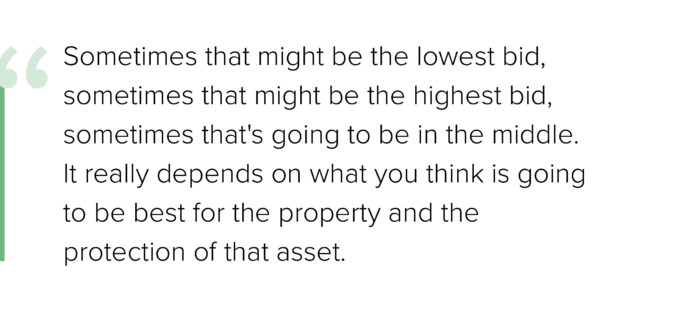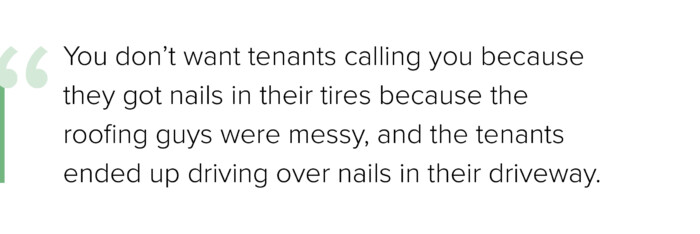It’s no secret that rental upkeep requires cautious coordination with tenants, distributors, and homeowners. It’s additionally time-sensitive—as a result of delays can frustrate residents, stall turnovers, and result in larger, costlier issues. In actual fact, analysis reveals that emergency repairs can price 3 to five instances extra than deliberate, routine upkeep. That’s why you will need to comply with confirmed workflows—to maintain work orders from falling by way of the cracks and snowballing into bigger points.
Automated Upkeep
Monitor each upkeep request, schedule repairs, and pay distributors multi functional place.
Be taught Extra
We sat down with property administration and course of options advisor Kelli Segretto of Ok Segretto Consulting to faucet into her 20+ years of expertise inside multifamily, single household, and LIHTC property administration. She shared the three most necessary property upkeep administration workflows each property supervisor ought to comply with and the right way to implement them.
Kinds of Property Upkeep Property Managers Deal with
Property upkeep workflows enable you systematically deal with the 4 fundamental sorts of upkeep work each property supervisor offers with:
- Routine upkeep: Common duties reminiscent of landscaping, pest management, and cleansing frequent areas
- Preventive upkeep: Proactive work to stop issues, like servicing HVAC techniques earlier than they fail.
- Corrective upkeep: Fixing damaged gadgets reminiscent of leaky taps or malfunctioning home equipment
- Emergency upkeep: Pressing repairs that may’t wait, reminiscent of burst pipes or heating system failures
Beginning From Sq. One: Getting Organized
Once you’re beginning out as a property supervisor, you might be dealing with a number of work orders your self or outsourcing them to distributors as wanted. That may work for some time, however ultimately you’ll need a repeatable workflow to scale what you are promoting.
Begin by documenting the way you’re at the moment dealing with property upkeep. Then make minor changes and tweaks. This provides you a preliminary upkeep administration workflow you’ll be able to enhance over time.
Three Upkeep Workflows Each Property Supervisor Should Have
That mentioned, you want three fundamental sorts of upkeep workflows:

- Work orders: Your go-to workflow for on a regular basis upkeep requests. How do you are taking a tenant’s ticket from submission to decision—with out letting something fall by way of the cracks?
- Turnovers: The step-by-step course of for getting a unit rent-ready after a move-out or when onboarding a brand new property.
- Giant tasks: For larger, high-cost jobs like window replacements or kitchen remodels, this workflow helps you propose, monitor progress, and keep on finances.
Subsequent, we’ll define what to incorporate in every of those three property upkeep administration workflows.
The Work Order Workflow: A Step-by-Step Information
Work orders are the commonest kind of upkeep you take care of as a property supervisor. Consequently, it’s necessary to have a strong workflow for dealing with them.
1. Obtain Upkeep Request
As a property supervisor, you usually get work orders by telephone or a web based tenant portal. Both method, you should definitely acquire them in a central software program the place you’ll be able to monitor them. Then affirm to tenants that you just’ve obtained their request and it’s being processed.
Professional tip: Buildium’s upkeep request options make it straightforward to just accept, assign, and monitor a number of work orders on a central on-line platform.
2. Overview and Troubleshoot
As soon as a piece order is available in, begin by ensuring it’s clear. When you’re undecided what the problem is, chances are high your vendor gained’t be both. Take a second to make clear the request earlier than something will get scheduled.
In some circumstances, you’ll be able to resolve the problem remotely. For instance, if a circuit breaker tripped or a rubbish disposal is clogged, you’ll be able to troubleshoot with the tenant and instruct them on how they’ll repair the issue themselves. This protects you from needing to dispatch a vendor.
3. Schedule and Coordinate Restore
If the problem can’t be resolved remotely, dispatch a vendor. You may have them coordinate a restore time with the tenant instantly or act because the intermediary by getting the seller’s availability and scheduling with the tenant your self.
Notice: Until the proprietor has a enough upkeep reserve fund from which you might be approved to tug, you may additionally have to safe the proprietor’s approval and funding earlier than dispatching distributors.
4. Confirm Work Completion
Property managers ought to at all times comply with up with tenants to verify {that a} work order is accomplished in a well timed, clear, {and professional} method. This brings the property upkeep request full circle and allows you to get the tenant’s suggestions. When monitoring common tenant satisfaction scores, a fee of 90% or greater signifies that tenants are largely glad.

5. Pay Distributors
Lastly, remind the seller to ship an bill in the event that they haven’t already. Then pay them promptly from the proprietor’s upkeep reserve or funds secured beforehand.

Professional tip: Buildium’s accounting options can deal with a number of invoices that routinely combine with work orders, making vendor funds simpler.
The Turnover Workflow: A Step-by-Step Information
Unit turnover or make-ready workflows can range extensively, however they usually embody these steps:
1. Obtain Keys
Turnovers are triggered when a tenant strikes out of an present property or a brand new property is added to your portfolio. Both method, you’ll obtain keys to entry the unit so the work can begin.
2. Consider Scope of Work
Stroll by way of the property to find out what must be finished (aka the scope of labor). For instance, does the property have to be painted? Are there utilities that have to be turned on? Does the landscaping want consideration? Take notes on what supplies and distributors you want.
When you’re at it, think about optionally available enhancements to the property, reminiscent of upgrading the cupboards, flooring, or fixtures to lift the rental’s worth. Then get the proprietor’s approval.
3. Dispatch Distributors
After figuring out the scope of labor, assign and schedule upkeep duties with the suitable distributors or in-house employees.
Professional tip: Use Buildium’s vendor profile options to arrange and fee distributors, so you’ll be able to rapidly assign work orders to the perfect group for the job.
4. Carry out a High quality Verify
Conduct a closing walkthrough to examine that every one upkeep work was accomplished as agreed. 
5. Mark Property as Market-Prepared
As soon as the property passes inspection, mark it as obtainable for itemizing to new tenants.
Notice: Your entire turnaround course of often takes about 3 days for multifamily properties and 1-2 weeks for single-family leases. Nevertheless, the shorter the turnaround time, the less emptiness prices the proprietor incurs. So construct robust relationships with dependable distributors who can ship high quality work rapidly.
The Giant Challenge Workflow: A Step-by-Step Information
What counts as a big upkeep mission varies, however it’s essential to finances for them. As a basic rule, property managers ought to goal to put aside 1% of a property’s buy worth for annual upkeep prices. Some property managers outline it as any mission that exceeds a sure price (e.g., $5,000) or length (e.g., two weeks). Nevertheless, you select to outline it, listed below are the steps concerned:
1. Outline Challenge Scope
As within the turnaround workflow, you will need to first settle the scope of labor. Decide what must be finished, who’s the perfect vendor for the job, and the way a lot money and time it’ll price.
Usually, this entails getting a number of bids from distributors by assembly them on web site or giving them property entry (e.g., by way of lockbox) to allow them to present an estimate. From there, you’ll be able to compile and examine bids.
2. Get Proprietor Approval
Current the proprietor with a closing mission estimate alongside along with your vendor advice.

3. Gather Proprietor Funds and Schedule Distributors
Upon getting the proprietor’s approval, acquire funds from them to pay for the mission. With Buildium, you are able to do this instantly by way of their proprietor portal.
Subsequent, schedule the work with the chosen distributors. If that is your first time working with them, examine that you’ve got all obligatory contracts, insurance coverage, and paperwork in place.
4. Execute and Oversee Challenge
At this level, you’ll be able to let the mission start. Repeatedly examine in on the mission’s progress so to replace the proprietor on milestones and any setbacks.
As well as, keep in shut contact with tenants and distributors all through. That method, you’ll be able to deal with any questions or considerations rapidly to reduce delays or conflicts.
5. Do a Ultimate Inspection and Pay Distributors
As soon as the seller notifies you that the job is finished, do a closing inspection. Verify that the work is full and the job web site is clear. This can be a step that property managers usually miss.

Lastly, make sure that to pay your distributors on time. As Segretto factors out, well timed funds construct belief and loyalty—making distributors extra prone to prioritize your jobs and reply rapidly while you want them.
Selecting Between In-Home vs Outsourced Upkeep
One of many huge questions all of us face is whether or not to construct an in-house upkeep group or depend on exterior distributors. There’s no single proper reply. It actually will depend on your portfolio and enterprise objectives.
In-house upkeep advantages:
- Extra management over scheduling and high quality
- Quicker response instances for routine requests
- Works properly if in case you have items clustered in a single space
Outsourced upkeep advantages:
- No payroll, coaching, or staffing overhead
- Entry to specialised specialists for plumbing, electrical work, and many others.
- Pay solely while you want the service
Many property managers discover a hybrid method works finest: an in-house particular person for small, on a regular basis duties and trusted distributors for larger or specialised jobs.
Software program to Assist with Property Upkeep Administration Workflows
When you can run by way of property upkeep administration workflows from paper checklists, it’s a lot simpler to run by way of them with customizable property administration software program.
With Buildium’s all-in-one upkeep administration platform, you’ll be able to coordinate with tenants, distributors, and homeowners at each stage of the upkeep life cycle. Whether or not you’re dealing with work orders, unit turnarounds, or massive tasks, Buildium can maintain you organized and on monitor.
Join your free 14-day trial or schedule a customized demo at present to see how Buildium can take your property upkeep administration workflows to the subsequent stage.
Continuously Requested Questions About Property Upkeep Workflows
How Do I Prioritize Upkeep Requests?
Categorize requests by urgency: emergency points affecting security come first, adopted by pressing non-emergency repairs, then routine requests. Talk this method to residents to handle expectations.
What Is the Distinction Between Preventive and Reactive Upkeep?
Reactive upkeep occurs after one thing breaks, whereas preventive upkeep entails common inspections to catch points early. upkeep plan consists of each approaches; whereas the optimum combine will depend on the portfolio, one basic rule of thumb suggests the default ratio is 80/20 for preventive versus corrective upkeep.
How Lengthy Ought to a Typical Upkeep Workflow Take?
Work orders usually take 24-72 hours, turnovers want just a few days to 2 weeks, and huge tasks range by complexity. Clear timeline communication with residents and homeowners is essential.
Learn extra on Upkeep











